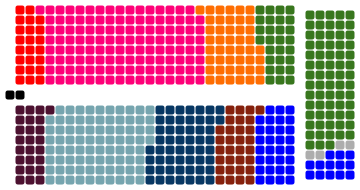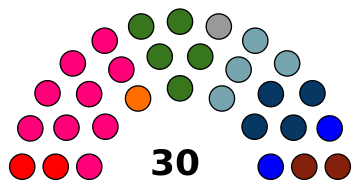1925 Kyotakavian general election
This article is incomplete because it is pending further input from participants, or it is a work-in-progress by one author. Please comment on this article's talk page to share your input, comments and questions. Note: To contribute to this article, you may need to seek help from the author(s) of this page. |
| ||||||||||||||||||||||||||||||||||||||||||||||||||||||||
All 535 seats to the Legislative Assembly 268 seats needed for a majority | ||||||||||||||||||||||||||||||||||||||||||||||||||||||||
|---|---|---|---|---|---|---|---|---|---|---|---|---|---|---|---|---|---|---|---|---|---|---|---|---|---|---|---|---|---|---|---|---|---|---|---|---|---|---|---|---|---|---|---|---|---|---|---|---|---|---|---|---|---|---|---|---|
| Turnout | 92.68% ( | |||||||||||||||||||||||||||||||||||||||||||||||||||||||
This lists parties that won seats. See the complete results below. | ||||||||||||||||||||||||||||||||||||||||||||||||||||||||
| ||||||||||||||||||||||||||||||||||||||||||||||||||||||||
Legislative Elections were held in the Svozgardan protectorate of Kyotakavia on the 1st January 1925 to elect all 535 representatives of the Kyotakavian Assembly, as well as 10 of the 30 State Ministers in the Kyotakavian State Ministerial Council. Kyotakavian Representatives are elected from 110 First Past the Post Constituencies, 400 Proportional Seats and 25 Svozgardan reserved seats whilst State Ministers are elected through an STV election in the state. To qualify for Proportional Seats, a party must reach 3.00% of the vote.
The result was a landslide 10.6 swing to the Kyotakavian United Syndicalist and Socialist Coalition. This swing came largely from the three traditional parties of government, the Workers' Party, Populists and the Traditionalists all who suffered catastrophic losses in seats though it is important to note that a large amount of the Syndicalist vote came from new voters who had not participated in the last few elections. Parties on the fringes of politics, specifically the KPK and the Front saw substantial increases in their vote share and more than doubled their representation in the Assembly. The NLP also saw a large upswing in support, restored to significant political position for the first time since the Second War of Kyotakavian Independence with the victory being especially significant for them as two gains were Constituency Seats from the SLA in the ethnically diverse towns of Nowa Grudak and Soborski.
The election was remarkable for several reasons, first the significant victory of the Syndicalist Party under Johaan Calstaunas which was the highest vote share and largest seat count ever won by a party at an election for the Legislative Assembly. Whilst a successful election had been predicted at the start of campaigning, Calstaunas was noted as a particularly charismatic speaker for the Syndicalist Party, as well as a record as a very young party moderate and determined nationalist that analysists believe endeared him to many voters who may have not otherwise supported the KUSSC. The turnout for this election was also the highest seen, with nearly 93% of the nation voting, contributing significantly to the strong electoral performance of fringe parties and the KUSSC. The Svozgardan Loyalist Alliance, for the first time either as themselves or as the King's Representation Committee, lost every seat they held except for the 25 reserve seats that they were assured under the Constitution.
Initially, little particular attention was paid to the government formation process as mathematically Alliance, the Workers' Party and KUSSC had 268 seats and could be expected to govern with small concessions to the Independents in the Assembly, despite this, the KUSSC instead chose to align with the NLP. The government therefore represented a major political coalition of Nationalist parties, and after approval from all participants, it was widely considered that this political move anchored the Government along lines of strict opposition to the SLA and to the national Svozgardan government.
Background
The Populist-Traditionalist government of Stefan Kobovic had lead the national picture of Kyotakavia for a decade with two successive election wins for the parties of government though neither had been a majority for the two and Kobovic had been reluctant to draw another, "less reliable" party into the government, especially as such a move would almost certain bring a more Nationalist party into the government and necessitate concessions on the reform agenda. This however had left the Government reliant on the abstention of the SLA from none-constitutional issues and the Populists and Traditionalists had become increasingly unpopular, seen as "collaborators" with the Svozgardan government due to their reliance on the SLA.
The "collaboration" issue was a major one however, and the role that the Svozgardan Loyalist Alliance had played in ensuring the continuance of Populist Government following the 1920 Kyotakavian general election led to a deep political resentment on the part of the Kyotakavians aimed towards the Svozgardans, heightening tensions to their "highest level since the first war" in the words of political analysis Stuzak Kotberji. KUSSC, Alliance and the NLP had all undertaken significant Paramilitary mobilisation programs over the last five years in the wake of a growing resentment, especially the KUSSC-aligned Union Guard which had seen a 150% increase in size over that timeframe.
The KLA had also responded not just with an armed build up, but an increasing volume in the number of armed clashes between themselves and the Svozgardan Armed Forces with 27 clashes, ambushes and skirmishes between 1923-1924 which resulted in the deaths of 17 Kyotakavians and 28 Svozgardans. This further contributed to a tense political climate that was building, especially as violence on the streets of Nowa Grudak between the KLA, Union Guard troops and Svozgardan Paramilitaries killed 58 in July 1924 alone. Indeed by November, Svozgardan Police had lost control of the situation along the Mbersk Road, a dividing line between the Kyotakavian and Svozgardan communities, with paramilitary forces essentially running law and order in the area, a situation which would continue up to election day and saw polls on each side protected by paramilitaries.
Economically the situation had taken a turn for the worse since 1923 as the taxation arrangement with Svozgarda saw a total of 5% of GDP extracted abroad and specifically invested into Svozgardan communities, necessitating a series of economic cuts and tax increases which directly contributed to a significant decline in the quality of life for many working-class Kyotakavians, especially in Jepultipac and Nodstok.
Despite this, there didn't seem to be a reliable political threat to the incumbent government as whilst losses were predicted, the continued ill fortune of the Workers' Party meant that it was unlikely to be that there was significant enough electoral threat.
Campaigning
November Campaigning
With candidate declaration concluding the 31st October, campaigning began in earnest on the 1st November with the first visit from a party leader being Johaan Calstuanas in his own seat of Rezgernorsk at 07:21.
October Campaigning
Polling Day
On polling day KUSSC, Alliance and the NLP made substantial use of paramilitary forces to bus voters to nearby polling stations in order to ensure that as many people got out to vote as possible, there were some claims of intimidation and coercion though cases of this remained relatively low outside of Jepultipac and Nodstok. Indeed in Kyotakas, some constituency seats reached 90+ turnout on the back of hard work put in by Nationalist parties to turnout voters, and indications given suggested that a large number of these voters would turnout for parties other than those which brought them to the station. The end result in the three western states was a major uptick in turnout for the three major Nationalist parties as well as a significant shifting in the political demographics as voters changed from the Populists to more radical alternatives.
Polling stations were also brought into factories and mines in many western states, enabling workers to vote far more easily to the benefit of KUSSC who saw industrial town turnout increase by an average of 10-15 points this election, with large numbers of working-class people coming out in support of the party.
Jepultipac and Nodstok suffered heavily from polling day violence however, in stark contrast to their western counterparts, the ethnic divisions in several major cities spilled into open warfare and at least three polling stations in the Svozgardan-side of Nowa Grudak were overrun by KLA militia and were shut down, contributing to the loss of constituency seats in the city. Svozgardan Police were forced out of Kyotakavian polling stations and a gun battle erupted outside of Precinct 12 Headquarters on Mtelsk Street between the KLA and KPP Officers.
Results
| Party | Votes | % | Proportional | Constituency | Total | ||||||
|---|---|---|---|---|---|---|---|---|---|---|---|
| Seats | Seats | Seats | ± | ||||||||
| KUSSC | 5,542,172 | 24.97% (+13.54) | 101 | 27 | 128 | +69 | |||||
| Alliance | 4,299,006 | 19.37% (+4.08) | 78 | 19 | 97 | +20 | |||||
| Populists | 3,496,820 | 15.75% (-7.62) | 65 | 18 | 83 | -40 | |||||
| Traditionalists | 2,158,366 | 9.72% (-9.17) | 41 | 13 | 54 | -45 | |||||
| Workers' Party | 2,196,038 | 9.89% (-7.08) | 41 | 4 | 45 | -39 | |||||
| NLP | 2,034,271 | 9.16% (+4.25) | 38 | 7 | 45 | +19 | |||||
| The Front | 963,952 | 4.34% (+2.30) | 19 | 12 | 31 | +25 | |||||
| KPK | 886,393 | 3.99% (+1.36) | 17 | 6 | 23 | +19 | |||||
| SLA | 620,475 | 2.80% (-1.66) | 25 | 0 | 25 | -26 | |||||
| Independents | N/A | N/A | 0 | 4 | 4 | -2 | |||||
| Party | State Ministers | State Presidents | Results | ||||||||
|---|---|---|---|---|---|---|---|---|---|---|---|
| Seats | Seats | Ministers ± | Presidents ± | ||||||||
| KUSSC | 9 / 30 |
2 / 5 |
+4 | +1 | |||||||
| Alliance | 5 / 30 |
1 / 5 |
+1 | +1 | |||||||
| Populists | 4 / 30 |
1 / 5 |
-3 | -1 | |||||||
| Traditionalists | 4 / 30 |
0 / 5 |
-1 | ||||||||
| Workers' Party | 1 / 30 |
0 / 5 |
-3 | ||||||||
| NLP | 2 / 30 |
1 / 5 |
+1 | +1 | |||||||
| The Front | 2 / 30 |
0 / 5 |
+1 | ||||||||
| KPK | 2 / 30 |
0 / 5 |
|||||||||
| SLA | 0 / 30 |
0 / 5 |
|||||||||
| Independents | 1 / 30 |
0 / 5 |
+1 | -1 | |||||||

